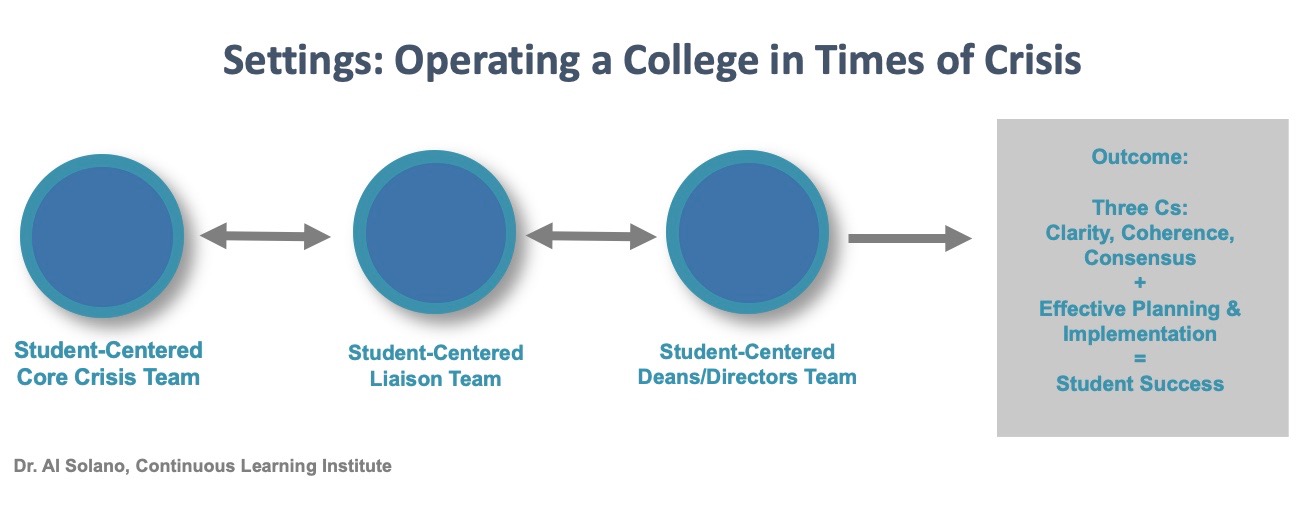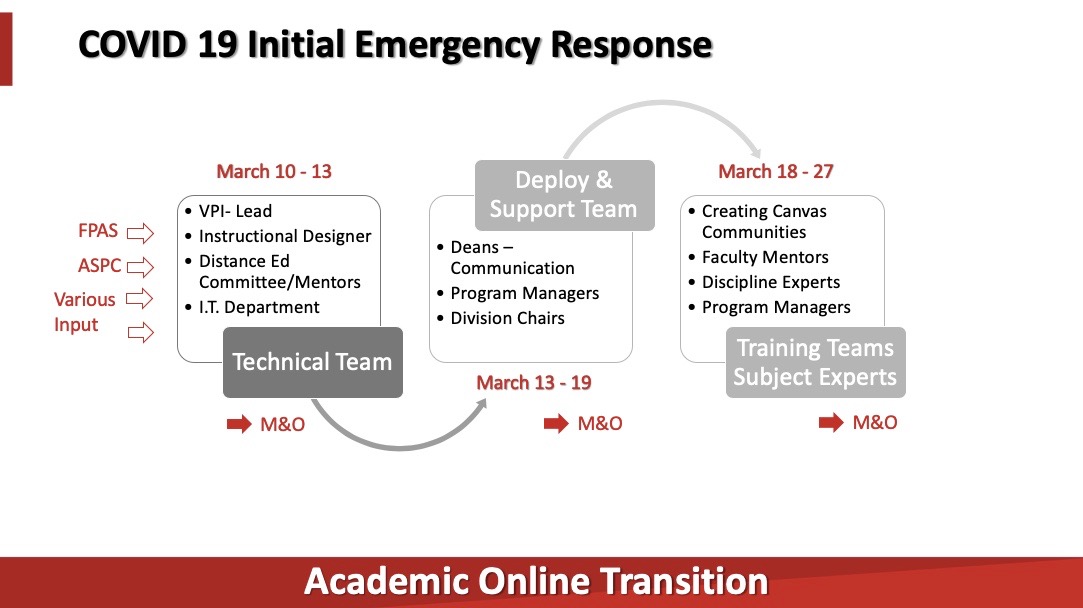Settings: Operating a College in Times of Crisis

(A. Solano)
March 15, 2020
Video also available via YouTube.
(Update: Scroll to the bottom for real-life examples that were influenced by this article.)
College committee structures tend to be slow-moving, inefficient bodies. They're often filled with interest group politics and unproductive meetings that result in time-lags and change (if any) that moves at glacial speed. It's a democratic way of doing business in higher education (with many pros), but let's not ignore the realities of shared governance (with its many cons). Therefore, meeting student needs in a time of crisis requires the courage to acknowledge that, at many institutions, the committee structure is rendered highly unproductive (some would say useless) in times of crisis because they weren't built to respond to pandemics. Institutions of higher education are being pushed to change the way they operate in the fastest pace ever to continue to serve students. This requires considering how settings for change should operate until the crisis is over.
A setting is simply a time and place for educators to get important work done. A setting is comprised of a series of meetings sewn together by sustained collaboration and teamwork around specific goals. In this case, it's the goal to meet the needs of students and employees during a crisis.
###

If experiencing high levels of miscommunication, lack of clarity, and time-lags to execute, it's a sign to trigger the following crisis settings structure:
Setting #1:
Student-Centered Core Crisis Team
Composed of:
President, Vice Presidents, Academic Senate President, Classified President, Institutional Researcher, Associated Students President
Purpose: To continually problem-solve how to meet the needs of students, and how to support personnel to meet the needs of students.
Meeting frequency: Wednesday, Thursday (and as needed). Set aside two hours for each day.
Technology: Video conferencing and shared docs
See how to ensure productive online meetings.
Setting #2:
Student-Centered Deans/Directors Team
Composed of:
Academic and student services managers who represent the front-line personnel; and an institutional researcher
Purpose: Continually assess the needs of students. Communicate findings via a online shared doc. Implement decisions made by the Core Crisis Team.
Meeting frequency: Monday, Wednesday, Friday (and as needed). Set aside 1.5 hours.
Technology: Video conferencing and shared docs
See how to ensure productive online meetings.
Setting #3:
Student-Centered Liaison Team
Composed of:
1-2 vice presidents/academic senate president from setting #1; and 1-2 academic and student services deans/directors from setting #2
Purpose: To serve as liaisons between settings #1 and #2 to clarify the continuing needs and decisions made to address the needs per the online shared doc.
Meeting frequency: One-hour daily check-ins (modified as needed)
See how to ensure productive online meetings.
###
These settings are sacred. No one should be allowed to hijack them to renegotiate contracts and the like. There is a time, place, and a process for grievances.
For those colleges that have managed to operationalize their student success teams, leverage them to implement decisions made by the Core Crisis Team!
Q&A:
Why aren't settings #1 & #2 combined?
It may be feasible at small campuses. But settings of 15+ people tend to be unproductive without a highly gifted facilitator. Also, the purpose of each setting is highly focused. The communication between the settings via technology and the liaison group is key, especially since the institution needs to be prepared to take these settings to Zoom.
Why do deans/directors meet Mondays, Wednesdays, and Fridays?
They're responsible for understanding student and employee needs, updating a living document for their team and the Core Crisis Team, and implementing decisions made by the Core Crisis Team.
Why does the Core Team meet on Tuesdays and Wednesdays?
The deans/directors team meets on Monday to provide information for the Tuesday Core Team meeting. Likewise, the Wednesday meeting for the Core Team's Thursday meeting. Friday is needed to consider how to continually plan and implement the decisions from the Core Crisis Team. The Core Team updates the online shared doc with decision made.
Why not call these settings committees?
I intentionally call these bodies teams instead of committees, workgroups, or task forces. These bodies need to behave like teams (those things that collaborate and don't waste entire meetings on interest group politics). A crisis response team structure is critical to maintaining operations (which means future job security) and must behave like a team. Furthermore, a recession maybe upon us sooner than we anticipate. Our inability to be nimble and behave like a team during a time of crisis will ensure that we fail our students (and ourselves). It doesn't mean there won't be debates, but the debates would be entirely focused on meeting the goals and needs of students.
Should initiatives such as equity and guided pathways continue?
There couldn't be a more urgent time to implement these priorities. Colleges need to continue to plan and implement how to help students clarify, enter and stay on a path, and above all, ensure learning; all through an equity lens. It means taking this important work to a virtual environment for an unspecified amount of time. But it’s complex work. That's why two simple, efficient team settings with a liaison team are critical in times of rapid change and crisis.
Try these settings and modify them as the work begins to best suit your institutional context.
Finally, don't forget to be kind in your settings by demonstrating courage, focus, commitment, respect, and integrity.

Stay safe. Stay strong.
We got this.
Onward...
***
For two real-life examples please see Cypress College President Dr. JoAnna Schilling's (partial) update to the board:
And Porterville College President Dr. Claudia Lourido-Habib's settings summary for the virtual campus transition and academic online transition:

***
Also visit:
Focus on the Basics: Doing Online Teaching Well
Free Online Course Shell with Weekly Structure
Resources: Transitioning to Online
Doing the Ordinary Extraordinarily Well






